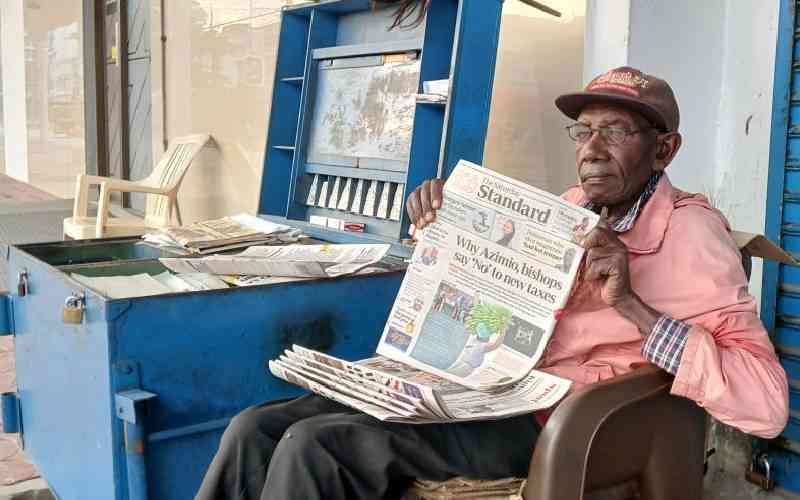Peter Musyoki, is a veteran newspaper vendor in Mombasa County. [File, Standard]
Political campaigns, populism competition among the political class, and catchy headlines focusing on governance issues, that are widely circulated in the evenings via digital platforms have provided revenue to newspapers, giving them a new hope for sustainability, providing alternative revenue. Print media readership and circulation in Kenya are picking up attributed to bold newspaper headlines on matters of public interest and the heightened political exchanges. While the figures for overall news consumption ranks newspapers a distant fourth from TV, radio and social media, through innovative approaches from long reads, punchy headlines that are widely promoted on digital platforms to article summaries on self-promotion platforms, print media is surviving—circulation figures are increasing steadily.
Away from the challenges of dwindling revenues from advertising, shrinking markets and competition especially from digital platforms, print media faces hurdles caused by high taxes on the broadsheet, operational costs related to printing and distribution of newspapers, professional news gathering and costs of defamation suits.
An interim study of news circulation figures in Kenya by the Media Council of Kenya shows that prevailing political conditions and newspaper headlines determine whether a newspaper is sold in a region or not. Other factors affecting the sale of newspapers include timeliness of newspaper delivery, entertainment, accessibility of the newspaper, sports news, and most important promotions through newspaper review segments in TV and radio.
Follow The Standard
channel
on WhatsApp
Weekend newspapers; Saturday and Sunday editions, record the highest circulation figures, while morning hours are the peak selling hours of newspapers as most vendors reported to have at least a regular customer buying newspapers daily. While some vendors reported that the days of the week did not determine any trend in sales, a big number of vendors reported better sales over the weekends. The Standard and Daily Nation dominate the circulation figures, with publications with specialist content or inserts on business, sports, agriculture and regional economic blocs pulling the biggest readers, indicating interest from readers on deep, well done long reads with public interest touch.
The Kenyan media landscape has undergone significant changes since enacting legislation that operationalised, articles 33, 34, and 35 of the Constitution aimed at protecting media freedom and freedom of expression. This followed other key events in the history of the industry including the liberalisation of the airwaves in 1992 and the digital migration in 2016. This has seen an exponential growth in the sector, which currently has seen the country register 100 print publications, 135 TV stations and over 300 radio stations. However, the growth in the sector has not seen a relative development in terms of job creation, quality of content, diversity and plurality in voices and both viability and sustainability.
With the proliferation of digital media and citizen journalism, the old business model for sustainable media outlets has come into question in the 21st century. Not much is known about the promotion of media sustainability in emerging markets such as Kenya. Media players need to enhance knowledge on media sustainability by stimulating, identifying and aggregating knowledge and best-case studies that will generate a variety of practice-oriented information tools that can be used by the media industry in Kenya and Africa at large.
Mr Bwire is the Director, Media Training and Development at the Media Council of Kenya
Follow The Standard
channel
on WhatsApp
By Victor Bwire


